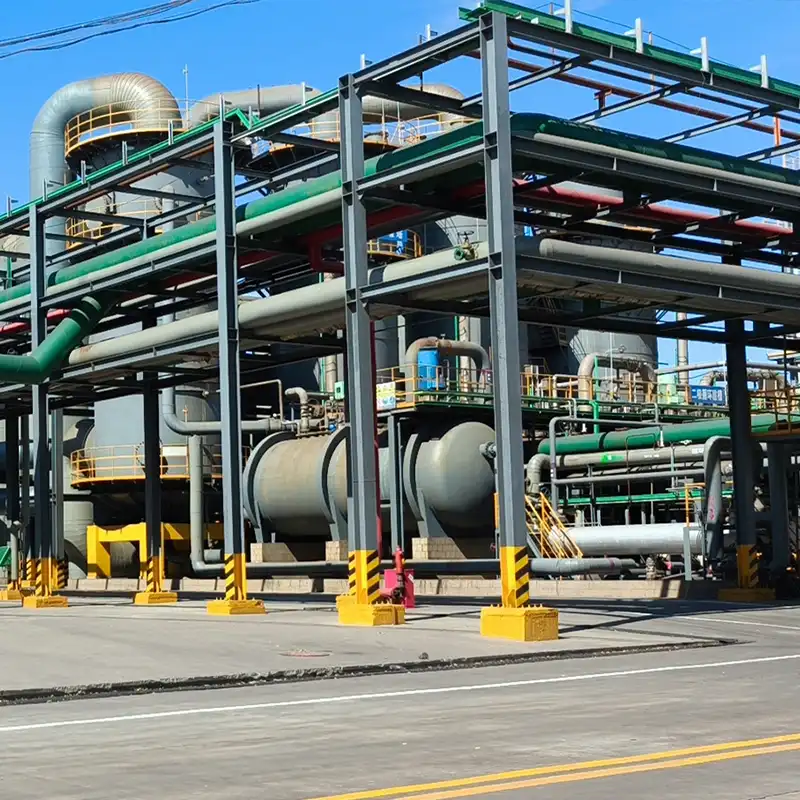What Are the Key Factors to Consider When Selecting a Sulfuric Acid Production Line?
A good sulfuric acid setup balances production needs, material suitability, energy savings, and protection. Below, we explain the main points to check before buying a production system.
Production Capacity Requirements and Scalability
Start by figuring out your needed output size. Whether you run a medium fertilizer maker or a big petrochemical firm, the setup must handle current needs. It should also allow for future growth. A flexible system lets your facility adapt when demand rises. This avoids rebuilding everything later.
Compatibility with Raw Materials and Feedstock
Different fields use various materials like pure sulfur, pyrite, or used acid. Your chosen setup must work well with these materials. This improves yield and cuts waste. For example, some methods work better with pure inputs. Others manage recycled or lower-grade stuff well.
Energy Efficiency and Environmental Compliance
Modern plants must follow strict environmental rules while saving energy. Systems with waste heat recovery, better absorption towers, and gas cleaning tech cut emissions. They also lower running costs. The tail gas meets standards after cleaning. This follows local environmental laws and supports green industry work.
Automation, Control Systems, and Operational Safety
Modern control systems like PLC and SCADA are key for steady quality and safety. They reduce mistakes and save labor costs. These systems manage production and adjust material mix. Protection features are also crucial. These include emergency stops, leak sensors, and explosion-safe gear.
Hebei Aoliande Chemical Equipment Co., LTD. has both building and planning skills for materials, layouts, and goods. This makes them a strong partner for these technical needs.
How Do Different Technologies in Sulfuric Acid Production Compare?
Knowing the good and bad points of contact processes versus DCDA systems helps match methods to your money and output aims.
Contact Process vs. Double Contact Double Absorption (DCDA)
The common contact process changes sulfur dioxide (SO₂) to sulfur trioxide (SO₃) using a catalyst. Then it absorbs into water to make H₂SO₄. The DCDA approach adds a second absorption step. This greatly boosts conversion rates—often above 99%. It cuts SO₂ releases sharply and lifts overall plant results.
Differences in Equipment Design and Performance
DCDA setups need extra towers and heat exchangers compared to single-stage contact processes. This raises first costs. However, it gives better yields and fewer emissions later. Your choice depends on budget limits versus long-term running goals.
Cost Implications of Each Technology Type
DCDA systems cost more upfront due to trickier plans and gear needs. Yet they offer better return through improved efficiency and rule compliance. Plants using older contact methods might have higher running costs from weaker conversion rates.
Using new methods, careful work, solid quality, and full service, Aoliande helps customers pick the best method for their money plans.
Which Industry Applications Influence Your Production Line Choice?
Your sector—fertilizers, mining, or petrochemicals—sets priorities like purity, rust resistance, or non-stop work.
Chemical Manufacturing and Fertilizer Industries
Sulfuric acid is key for making phosphoric acid for fertilizers and other chemicals like hydrochloric acid or nitric acid. These fields usually need very pure output with steady supply chains.
Metal Processing and Mining Operations
For mining uses like copper leaching, the focus is more on strong system design. It must handle harsh settings rather than extreme purity.
Petrochemical and Refinery Applications
Petrochemical fields demand continuous operation with little downtime. Plants here must fit smoothly with current refinery work. They also ensure safety against risky reactions.
Aoliande set up separate lines for different goods. This shows their fit across many fields including metalwork, waste gas cleaning, and power plant desulfurization. It makes Aoliande a flexible choice for different uses.
What Role Does Customization Play in Meeting Specific Industrial Needs?
Made-to-order solutions tackle place-specific issues, from space limits to future growth plans.
Tailoring Plant Design to Site Conditions
Location affects things like outside temperatures and utility access. Custom plans allow adjustment to local weather or space limits on-site.
Integrating with Existing Infrastructure
For companies growing current facilities or updating older plants, joining ability is vital. Custom engineering ensures new systems work well with old equipment. This avoids big breaks.
Flexibility for Future Expansion or Upgrades
A building-block method lets businesses grow operations later without major changes. Custom work here includes saving space for extra reactors or towers. These can be added later.
Our company gives customers technical help, goods and material supply, moving, and setup watching. This complete custom service makes Aoliande a top partner for tailored project work.
Why Is Supplier Selection Critical to Project Success?
A provider’s know-how, quality rules, and after-sale help decide your plant’s life performance.
Evaluating Supplier Experience and Project Portfolio
A provider’s past shows their reliability. Look for sellers who have done tricky jobs worldwide in different fields.
Assessing Engineering Capabilities and Quality Standards
Papers like ISO9001 confirm they follow worldwide quality systems. Passing ISO9001, ISO14001, OHSAS18001 shows strong promise to quality at every making step.
After-Sales Service, Training, and Technical Support
Good support ensures smooth starting and long repair success. Learning programs also prepare your team for better work later.
Goods have gone to places worldwide…and earned support from new and old buyers. This global reach shows Aoliande’s trust as a solid provider for sulfuric acid setups.
Who Is Aoliande and Why Consider Them as Your Sulfuric Acid Production Line Partner?

Hebei Aoliande mixes new technology, worldwide job history, and full custom work for ready solutions.
Overview of Aoliande’s Expertise in Sulfuric Acid Plant Solutions
Hebei Aoliande Chemical Equipment Co., LTD. focuses on chemical gear making including potassium sulfate reactors. This involves handling sulfuric acid, showing useful skills for full H₂SO₄ plants.
Key Strengths: Advanced Technology, Reliable Engineering, Global Projects
Through steady growth in skill and methods…using new technology, they give solid engineering answers proven in markets like USA, Brazil, and Japan.
Commitment to Quality, Compliance, and Customer Satisfaction
With papers like ISO9001/14001/OHSAS18001 and full service, clients get full value—from talks to starting help. This makes them a top pick when choosing a sulfuric acid setup provider for your field needs.
Conclusion
Hebei Aoliande Chemical Equipment Co., LTD. stands out as a reliable partner, offering advanced solutions, global experience, and tailored support to ensure long-term success. Whether upgrading existing systems or building new plants, choosing the right setup will enhance efficiency, compliance, and profitability in your operations.
FAQs About Choosing a Sulfuric Acid Production Line
What is the typical lifespan of a sulfuric acid production line?
With good repair steps—including rust-resistant materials—the average life is 20–30 years based on use level.
Can a sulfuric acid plant be upgraded after initial installation?
Yes. Building-block designs allow improvements like extra absorption stages. These can be added without stopping main work.
How long does it take to commission a new sulfuric acid production line?
Time varies by difficulty—from simple contact setups to complex DCDA designs. Starting takes 6 months to over 1 year including testing.
For inquiries, reach us on WhatsApp at +86-13363884492 or email belen@aldfrp.com.






